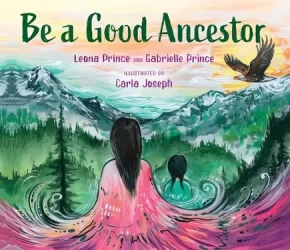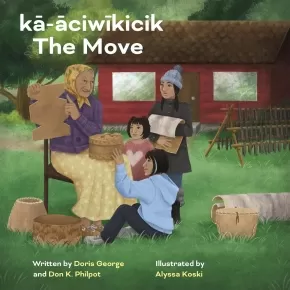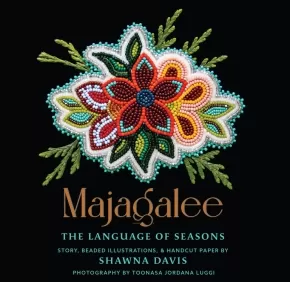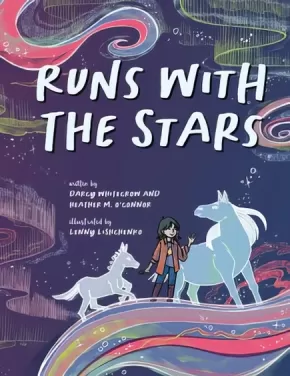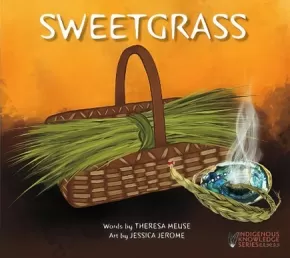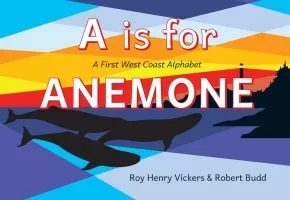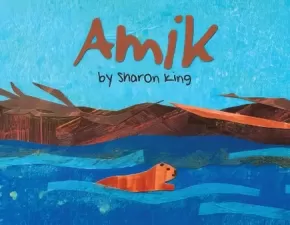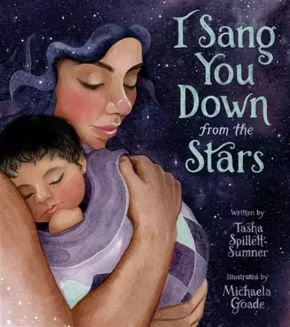
From Sea to Sea to Sea 2023 Edition
1
-
15
of
24 Results;
Sort By
Go To
of 2
Be a Good Ancestor
$21.95
Artists:
Format:
Hardcover
Text Content Territories:
Indigenous Canadian; First Nations; Dene; Dakelh (Carrier);
ISBN / Barcode: 9781459831407
Synopsis:
Synopsis:
Rooted in Indigenous teachings, this stunning picture book encourages readers of all ages to consider the ways in which they live in connection to the world around them and to think deeply about their behaviors.
Addressing environmental issues, animal welfare, self-esteem and self-respect, and the importance of community, the authors deliver a poignant and universal message in an accessible way: Be a good ancestor to the world around you. Thought-provoking stanzas offer a call to action for each one of us to consider how we affect future generations. Every decision we make ripples out, and we can affect the world around us by thinking deeply about those decisions.
Awards
- 2023 Forest of Reading Blue Spruce Award
- 2023 Ruth and Sylvia Schwartz Children's Book Awards - Children's Picture Book
Reviews
"Be A Good Ancestor is a story rooted in Indigenous teachings that ask readers to examine how they connect to the world around them and think deeply about their actions' consequences. The story looks at environmental issues, animal welfare, self-esteem and self-respect, and the importance of community making the delivery of a universal message accessible." - The Dalai Lama Center
Educator Information
Recommended for ages 3 to 5.
This book is available in French: Laisse un bel héritage.
Additional Information
32 pages | 10.00" x 8.50" | Hardcover
kā-āciwīkicik / The Move (PB)
$14.95
Format:
Paperback
Text Content Territories:
Indigenous Canadian; First Nations; Cree (Nehiyawak); Swampy Cree ; Chemawawin First Nation ;
ISBN / Barcode: 9781772034288
Synopsis:
Synopsis:
A magical children’s picture book, written in Cree and English, depicting the transformation of a barren landscape into a rich natural world where an elderly couple can spend their remaining days.
Rooted in the historical displacement and relocation of members of the Chemawawin First Nation from their ancestral homeland, The Move is a bilingual story of two Cree Elders adjusting to life in their new environment. The story presents two contrasting landscapes of the old community—the homeland of the Chemawawin People—and the new community of Easterville, which at first appears barren and lifeless. Gradually, the couple begins to incorporate their old customs and traditions into their current surroundings. Family members begin to visit, and eventually nature begins to bloom all around them. Through traditional Cree storytelling techniques and vivid imagery, the new landscape springs to life and becomes a true community, filled with life and happiness.
Reviews
“kā-āciwīkicik / The Move is a small treasure. A wonderful story about memory, land, and kinship, and how language is integral to our relations with each other and with the land and all living things. This is a moving story of hope, wonderfully illustrated in tones that feel like earth, and with translation into Cree it invites us in, like a crackling fireplace in a log cabin, to sit with a cup of tea in hand and learn the old stories.” —Paul Seesequasis, bestselling author of Blanket Toss Under Midnight Sun
“My experience reading kā-āciwīkicik / The Move was profound. From the dreariness of relocation and searching for hope to finding happiness in reconnecting to culture—this story is both educational and poetic. Doris, Don and Alyssa balance healing in two worlds and do it beautifully through words, storyline, and graphics.” —Shayla Raine, author of The Way Creator Sees You
Educator Information
Recommended for ages 4 to 8.
Dual-Language: Cree and English.
Additional Information
48 pages | Paperback
Majagalee: The Language of Seasons
$22.00
Artists:
Format:
Hardcover
Text Content Territories:
Indigenous Canadian; First Nations; Gitxsan (Gitksan);
ISBN / Barcode: 9781990458002
Synopsis:
Synopsis:
Shawna Davis invites the reader to explore each of the four seasons through her beautiful words and lush, unforgettable, beaded illustrations.
We begin in Gwooyim (Spring) when the Majagalee, the Sim Algyax word for “flower,” are just beginning to sprout. We then move on to Sint (Summer) when Grandmother Sun stays in the sky a bit longer. Next there is Xwsit (Fall), just as Summer begins to get sleepy, and Maadim (Winter) where the snow has fallen and the freezer is full.
This is a story of nature, its importance to our lives, and why it must be cared for and respected.
Toonasa Jordana Luggi’s lovely, rich, and nearly tactile photographs are the perfect complement to Shawna’s hand-beaded artwork and wonderful, hand-cut paper backgrounds.
Includes Pronunciation Guides.
Reviews
“...simple, evocative poetry is culturally specific, rooted in a deep love of the land and the people around her but it’s also relatable to readers of different backgrounds. The lyrical verse in Majagalee makes it an ideal read-aloud book.... Majagalee is an elevated concept book. It introduces readers to the seasons, the plants and animals of the Northwest Coast, Sim Algyax, Indigenous art, and the importance of all these things to Gitksan culture. Despite its apparent simplicity, Majagalee is a complex and brilliantly constructed book. It will appeal to Indigenous and non-Indigenous readers alike, and for teachers and parents, it serves as an outstanding example of a book that demonstrates the ongoing presence and beauty of Indigenous cultures in what is now known as Canada..” – Quill & Quire, starred review
Educator Information
Juvenile Fiction. This picture book explores the four seasons on the northwest coast of what is currently British Columbia from a Gitksan perspective.
Additional information
Pages: 40
nimosôm anima--nimihšōmihš ta-minciwēnciman: Grandfather's Reminder
$19.95
Artists:
Format:
Hardcover
Text Content Territories:
Indigenous Canadian; First Nations; Anishinaabeg; Ojibway; Saulteaux; Cree (Nehiyawak); Plains Cree;
Grade Levels: Kindergarten; 1;
ISBN / Barcode: 9781988783826
Synopsis:
Synopsis:
“We need to be careful that we don’t hurt the gifts that are given to us.” Told in Plains Cree, Saulteaux, and English, this simple tale of traditional teachings and values follows a grandparent and grandchild on a visit to a chokecherry patch, where lessons about respect and gratitude for the earth’s gifts are shared.
Educator Information
Recommended for ages 3+
Triple-language format: Plains Cree, Saulteaux, and English.
An afterword includes a Saulteaux and Plains Cree pronunciation guide.
Additional Information
40 pages | 11.00" x 8.50" | Hardcover
Runs with the Stars
$19.95
Artists:
Format:
Hardcover
Text Content Territories:
Indigenous Canadian; First Nations; Anishinaabeg; Ojibway;
ISBN / Barcode: 9781772602388
Synopsis:
Synopsis:
“Elders say they were always here. The horses were small, but strong.”
“Like me?”
“Like you.”
As they await the birth of a new foal, a man teaches his grandchild about the Ojibwe Horses that used to roam the forests of northwestern Ontario. The horses once ran wild and free, but when Grandfather was a boy, they almost disappeared. Now he is the caretaker of his own small herd, keeping the breed alive for future generations and teaching his grandchild about the loving bond between human and animals.
Educator Information
Recommended for ages 6 to 8.
This book is available in a dual-language format: Wiijibibamatoon Anangoonan/Runs with the Stars
Subjects: Character Education; Family & Friendship; History & Social Studies; Canadian History; First Nations & Indigenous Peoples; Science; Environmentalism; Conservation and stewardship; Reflecting Diversity
Additional Information
32 pages | 8.50" x 11.00" | Hardcover
Sweetgrass
$12.95
Artists:
Format:
Paperback
Text Content Territories:
Indigenous Canadian; First Nations; Mi'kmaq;
ISBN / Barcode: 9781771089333
Synopsis:
Synopsis:
A modern story of traditional Indigenous knowledge that follows a young boy and his Auntie as they gather and braid sweetgrass, one of the four sacred medicines.
It's early July, and for Matthew and his Auntie that means one thing: time to go sweetgrass picking. This year, Matthew's younger cousin Warren is coming along, and it will be his first time visiting the shoreline where the sweetgrass grows.
With Auntie's traditional Mi'kmaw knowledge and Matthew's gentle guidance, Warren learns about the many uses for sweetgrass—as traditional medicine, a sacred offering, a smudging ingredient—and the importance of not picking more than he needs. Once the trio is back at Auntie's house, she shows the boys how to clean and braid the grass.
From the duo behind the bestsellers The Gathering and The Sharing Circle, this heartfelt story about the gifts we receive from Mother Earth and how to gather them respectfully offers thoughtful insight into a treasured Mi'kmaw tradition.
Sweetgrass grows in wet meadows, low prairies, and the edges of sloughs and marshes. It grows from Labrador to Alaska, south to New Jersey, Indiana, Iowa, New Mexico, and Arizona. Widely used by North American Indigenous Peoples from many different Nations, it is also considered one of the "four sacred medicines" by many Plains Indians.
Educator & Series Information
Recommended for ages 4 to 7.
This book is part of the Indigenous Knowledge Series.
This book is available in French: Foin d'odeur
Additional Information
32 pages | 9.00" x 8.00" | Paperback
Una Huna?: Ukpik Learns to Sew (HC)
$18.95
Artists:
Format:
Hardcover
Text Content Territories:
Indigenous Canadian; Inuit;
ISBN / Barcode: 9781772274332
Synopsis:
Synopsis:
Ukpik’s mother is eager to teach Ukpik how to prepare caribou skin, dry it, and use it to sew a pair of simple, useful mitts. But Ukpik can’t stop thinking about the beautiful new beads her mother traded the Captain for on his last visit. They are so bright and beautiful! Anaana knows it is more important for Ukpik to learn the skills she will need to make her own clothing in the cold Arctic climate, so she insists that Ukpik sit with her and learn the basics, while having a bit of fun, too. Though Anaana won’t let Ukpik sew with the new beads just yet, she does have a surprise for Ukpik that will let her enjoy the new-found treasures while also learning the skills she will need to provide for herself and her family.
Educator Information
Recommended for ages 6 to 8.
Additional Information
36 pages | 8.00" x 9.00" | Hardcover
FLASH SALE! A is for Anemone (BB)
$11.22 $14.95
Format:
Board Book
Text Content Territories:
Indigenous Canadian;
Grade Levels: Preschool;
ISBN / Barcode: 9781550179477
Synopsis:
Synopsis:
With crisp, luminous illustrations by celebrated Indigenous artist Roy Henry Vickers, and a simple rythmic text, this sturdy board book introduces the alphabet using iconic imagery of the West Coast, creating a book that will be cherished by young readers and their families.
Starting with colourful sea anemones waving in the ocean current, and closing with a snoozing grizzly bear (Zzz), this board book supports both early literacy and children's awareness of the natural world.
Publishers Weekly described Vicker’s previous collaboration with Robert Budd as “a gorgeous glimpse of the distinctive landscapes and creatures of the Northwest, [that] will enchant residents and nonlocals alike.”
Educator & Series Information
This book is a part of the First West Coast Books series.
Recommended for ages 3 and under.
Key Topics / Concepts: ABCs, Alphabet, West Coast, Indigenous, Canadian, Earth Sciences, Water, Literacy Development, Early Learners, Indigenous Artwork.
Additional Information
28 pages | 7.25" x 5.00" | Boardbook
Amik (BB)
$15.00
Artists:
Format:
Board Book
Text Content Territories:
Indigenous Canadian; First Nations; Anishinaabeg; Potawatomi;
ISBN / Barcode: 9781928120285
Synopsis:
Synopsis:
The beaver is busy...
This delightful children's picture book tells the story of amik, the beaver, who works on his dam throughout the day while nature and the activities of other animals carry on around him. At the end of a long day, amik returns to his den to be with his family.
Along with its beautiful cut-paper illustrations, Amik offers the chance for children to learn words and phrases in the Ojibwe language, as the text appears in both English and Anishinaabemowin. A fun, colourful and engaging book for children ages three through six.
Educator Information
Recommended for ages 3 to 6.
Dual-language: English and Anishinaabemowin
Additional Information
20 pages | 9.00" x 8.00" | Board Book
Animals Illustrated: Wolverine
$15.95
Artists:
Format:
Hardcover
Text Content Territories:
Indigenous Canadian; Inuit;
ISBN / Barcode: 9781772272987
Synopsis:
Synopsis:
In this book, kids will learn how wolverines raise their babies, where they live, what they eat, and other interesting information, like how they use their distinctive scent and how they became known as the gluttons of the animal kingdom!
Reviews
"Niptanatiak shares the scientific facts about the animal in a very accessible and simple way, so despite its factual nature this book feels like anything but a boring textbook. A key focus of the facts is how the wolverine engages with its surroundings and other animals, making it a great way to introduce young readers to the Indigenous concept of relationality." - Excerpt from IBBY Canada's From Sea to Sea to Sea: Celebrating Indigenous Picture Books - 2023 Edition
Educator & Series Information
This book is part of the non-fiction Animals Illustrated series, which mixes fun-filled animal facts suitable for the youngest of readers with intricately detailed illustrations to create a unique and beautiful collection of children’s non-fiction books on Arctic animals. Each volume contains firsthand accounts from authors who live in the Arctic, along with interesting facts on the behaviours and biology of each animal.
Themes: Nunavut, Inuit, Indigenous, Arctic Animals, STEM
"A key focus of the facts is how the wolverine engages with its surroundings and other animals, making it a great way to introduce young readers to the Indigenous concept of relationality" - From Sea to Sea to Sea 2023 Edition
Recommended Ages: 6 to 8.
Available in French: Carcajou
Additional Information
28 pages | 6.50" x 9.00" | Hardcover
Berry Picking at Four Mile Bay - Nunavummi Reading Series
$20.95
Artists:
Format:
Hardcover
Text Content Territories:
Indigenous Canadian; Inuit;
ISBN / Barcode: 9781774502839
Synopsis:
Synopsis:
When Nekaloakyok was a young girl, she loved going berry picking with her Granny Nalvana. Based on the memories of the author, this book tells the story of a family trip picking akpiks and other berries at Four Mile Bay, near Kugluktuk, Nunavut. Join Nekaloakyok as she reflects on childhood memories and special moments spent with family.
Educator & Series Information
This book is part of the Nunavummi Reading Series, a Nunavut-developed series that supports literacy learning while teaching readers about the people, traditions, and environment of the Canadian Arctic. This book is a level 13 book in the Nunavummi Reading Series. Nunavummi Reading Series books have also been officially levelled using the Fountas & Pinnell Text Level Gradient™ Levelling System. This book's F&P level is O.
This is a story about tradition and multi-generational relationships based on the author's life growing up in Coppermine (now Kugluktuk). Inuktitut glossary included in endpages.
Recommended for ages 7 to 9.
Curriculum Connections & Keywords: Inuit traditions and ways of life; Indigenous History; Heritage; Memoir; Family
Additional Information
50 pages | 9.00" x 10.00" | Hardcover
Grandfather Bowhead, Tell Me a Story
$17.95
Artists:
Format:
Hardcover
Grade Levels: Preschool;
ISBN / Barcode: 9781772272970
Synopsis:
Synopsis:
Richly illustrated and lovingly told, this book is a warm and inviting read, perfect for sharing with any little one. Bowhead whales are the longest-living mammals on the planet, living over 200 years. In this heartwarming story, a grandfather bowhead recounts to his young grandchild calf all the beautiful, amazing, and surprising things he has seen in his lifetime, all while assuring the little calf that there is nothing more wondrous than the love a grandfather has for his grandchild.
Reviews
"Together with painterly illustrations in monochromatic blues of the ocean, this underwater tale shows the wondrous love of a grandparent for his grandchild...Tender words of affection are perfect for sharing with any young child or grandchild."—Kirkus
"The expansive illustrations, awash in marine blues and greens, capture the drama and majesty of the Arctic while also showcasing the tender relationship between the whales. A lovely choice for preschool storytimes."—Booklist
Educator Information
Recommended for ages 0 to 3.
Includes an Inuktitut pronunciation guide and fun facts about bowhead whales.
Themes: Indigenous, baby whale, bedtime book, Arctic, Iqaluit
Additional Information
28 pages | 9.50" x 9.50" | Hardcover
I Sang You Down from the Stars
$19.95
Artists:
Format:
Hardcover
Text Content Territories:
Indigenous Canadian;
Grade Levels: Preschool; Kindergarten;
ISBN / Barcode: 9781771474085
Synopsis:
Synopsis:
An Own Voices love letter from an Indigenous mother to her new baby, new from celebrated author Tasha Spillett-Sumner and 2021 Caldecott winning illustrator Michaela Goade
Drawing from Indigenous creation stories and traditional teachings and illustrated in dazzling watercolors, I Sang You Down from the Stars is a tribute to the bond between mother and child.
The narrator gathers gifts for a medicine bundle in anticipation of her baby’s birth; a fluffy white eagle plume, bunches of cedar and sage, a quilted star blanket, and a small stone from the river. When the baby arrives, the mother shares the bundle with her child and reveals the importance of each item inside. But when her family comes to meet the new arrival, she realizes the baby arrived with gifts of its own and that the baby is also a sacred bundle: a baby bundle.
Writing in simple, lyrical text, author Tasha Spillett-Sumner draws from her cultural heritage in order to celebrate Indigenous traditions and the universal nature of a mother’s love, with stunning art by the 2021 Caldecott medal winner for We Are Water Protectors, Michela Goade.
Reviews
"Gorgeous, shimmering, heartfelt." — Kirkus Reviews - STARRED REVIEW
"Gorgeous, shimmering, heartfelt." — Kirkus Reviews - STARRED REVIEW
"[Tasha] Spillet-Sumner's tender free-verse tribute to the joy of welcoming a new baby should resonate with any caregiver who has excitedly awaited a child's arrival... [Michaela] Goade's ethereal watercolor and mixed-media illustrations soar across the page, overflowing with gorgeous touches... I Sang You Down from the Stars will make a beautiful gift for an expecting family as well as a read-aloud to assure children they are loved." — Shelf Awareness
Educator & Series Information
Recommended for ages 2 to 5.
Recommended for ages 2 to 5.
Fountas & Pinnell Text Level Gradient: O
Lexile measure: AD640L
This book is available in French: Les étoiles m'ont chanté ton nom
Additional Information
32 pages | 9.00" x 10.25"
32 pages | 9.00" x 10.25"
Jigging for Halibut With Tsinii (5 in stock, in reprint)
$21.95
Artists:
Format:
Hardcover
Text Content Territories:
Indigenous Canadian; First Nations; Haida;
ISBN / Barcode: 9781553799818
Synopsis:
Synopsis:
Based on Haida artist Robert Davidson's own experiences with Tsinii (his grandfather), this beautiful story highlights intergenerational knowledge and authentic learning experiences.
Off the northern tip of Haida Gwaii, a boy goes fishing with his tsinii, his grandfather. As they watch the weather, jig for halibut, and row with the tides, there’s more to learn from Tsinii than how to catch a fish.
Written by the creators of Potlatch as Pedagogy, this book brings the Haida Sk'ad'a Principles to life through the art of Janine Gibbons.
Reviews
"My father said once that we cannot forget the importance of Elders. He was worried that we don’t respect them like we used to, and wanted that to change. This book is a love letter to Elders, who are our doorway to the past, to the traditions, languages, and ways of living that give us not just identity, but life. It is at once poetic and calming, in both its words and illustrations, and gifts knowledge to us from those that have been entrusted with it." — David A. Robertson, Governor General's Award-winning author
"I love this story! Beautifully illustrated. Beautifully told." — Katherena Vermette, The Girl and the Wolf
"Sara and Robert Davidson share a beautiful and tenderly written story that takes readers out for a day on the ocean with Robert and Tsinii (his grandpa). We are introduced to gaffs and jigging, the movements of the tides and skies, and the importance of traditional harvesting. Janine Gibbons’s artwork poetically captures the coastal atmosphere, and the love and care between grandson and grandfather. Absolutely stunning."— Julie Flett, author/illustrator Birdsong
Educator & Series Information
Recommended for ages 6 to 8.
This book is part of the Sk'ad'a Stories series.
Keywords & Themes: Haida, Haida Gwaii, Family, Elders, Intergenerational Knowledge, Fishing, Outdoor Activities, Traditional Knowledge, Traditional Harvesting, Coast.
Additional Information
40 pages | 8.12" x 9.00" | Hardcover
Mii maanda ezhi-gkendmaanh / This Is How I Know
$19.99
Format:
Hardcover
Text Content Territories:
Indigenous Canadian; First Nations; Anishinaabeg;
ISBN / Barcode: 9781773063263
Synopsis:
Synopsis:
Niibing, dgwaagig, bboong, mnookmig dbaadjigaade maanpii mzin'igning / A Book about the Seasons.
An Anishinaabe child and her grandmother explore the natural wonders of each season in this lyrical, bilingual story-poem.
In this lyrical story-poem, written in Anishinaabemowin and English, a child and grandmother explore their surroundings, taking pleasure in the familiar sights that each new season brings.
We accompany them through warm summer days full of wildflowers, bees and blueberries, then fall, when bears feast before hibernation and forest mushrooms are ripe for harvest. Winter mornings begin in darkness as deer, mice and other animals search for food, while spring brings green shoots poking through melting snow and the chirping of peepers.
Brittany Luby and Joshua Mangeshig Pawis-Steckley have created a book inspired by childhood memories of time spent with Knowledge Keepers, observing and living in relationship with the natural world in the place they call home — the northern reaches of Anishinaabewaking, around the Great Lakes.
Alvin Ted Corbiere and Alan Corbiere, father and son, are the Anishinaabe translators of this work.
Awards
- 2022 Indigenous Voices Award for a published work in an Indigenous language
Educator Information
Recommended for ages 3 to 7.
Correlates to the Common Core State Standards in English Language Arts:
CCSS.ELA-LITERACY.RL.2.1
Ask and answer such questions as who, what, where, when, why, and how to demonstrate understanding of key details in a text.
CCSS.ELA-LITERACY.RL.2.2
Recount stories, including fables and folktales from diverse cultures, and determine their central message, lesson, or moral.
CCSS.ELA-LITERACY.RL.K.6
With prompting and support, name the author and illustrator of a story and define the role of each in telling the story.
CCSS.ELA-LITERACY.RL.1.4
Identify words and phrases in stories or poems that suggest feelings or appeal to the senses.
CCSS.ELA-LITERACY.RL.2.5
Describe the overall structure of a story, including describing how the beginning introduces the story and the ending concludes the action.
How do you know the seasons? Do you know it's summer when blueberries fall readily and the sand is hot enough to sting? Do you know fall by the red-winged blackbird taking his leave? Take a minute and look around — nature is speaking to us. Changes are happening, and Mother Earth is letting us know at every step of the way. Whether it's the sun's bright morning light, or the white moon sitting high in the sky, there are many ways to know what time of the year it is. All we need to do is stop, look, and listen, because each season tells us a story!
This book is also available in French and Ojibwe: Mii maanda ezhi-gkendmaanh / La Terre me parle: Un livre sur les saisons
Additional Information
44 pages | 8.75" x 8.50"
Sort By
Go To
of 2

